


Correct Way to Stretch: Common mistakes are bouncing while stretching, pushing past the point of resistance, and not holding a stretch long enough. Don't bounce. Hold each stretch for at least 15 seconds, but preferably up to 30 seconds. Do three to four repetitions of each stretch. Don't try to stretch too far — only to the point of resistance. Tension should be felt, but it should never be painful. A good stretching session will leave you feeling relaxed and refreshed.
Decrease Muscle Soreness: Stretching at any time will increase blood flow to the muscles and can relieve tightness.
For Body & Mind: Increase confidence, control stress, and promote peace of mind. Yoga improves your posture and circulation and increases your flexibility, strength, and coordination.
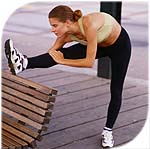
Increase Athletic Performance: If you take time to stretch, it will increase your athletic performance. A more flexible muscle is capable of exerting a greater force and will not fatigue as easily. Improving flexibility increases your range of motion, which allows you to react to the demands of running and working out. Along with increased explosiveness and speed, more flexible muscles lead to less chance of injury.
Increase Flexibility: The main purpose of stretching is to increase flexibility. An added bonus is the ability to improve athletic performance, prevent injury, and ease some soreness. Flexibility is part of the balance of a healthy lifestyle. To really gain flexibility, stretch after your workout. You can still stretch lightly before your workout, but make sure to get a sweat going before doing so.
What to Stretch: Focus on the muscles you use the most. For runners, you should stretch hamstrings (the back of your thighs), quadriceps (the front of your thighs), calves, hips, and back.
When to Stretch: Before or after? Both - if you have the time! But, be sure to jog lightly for 5-10 minutes to warm up your muscles before you stretch. Stretching cold muscles can lead to injury, so warming up first is important. If you're pressed for time, wait and stretch after you run. Stretching after you run is more beneficial for your increased flexibility since your blood is flowing and muscles are warm. A good stretching routine will enhance your performance through increased flexibility and stride length.
top of page
Runner Girl's Recommended Stretching Routine:
1. Hamstring Stretch: Lie on your back with one leg straight up in the air, the other bent with foot flat on the ground. Loop a strap or towel over the arch of the lifted foot, and gently pull on the strap as you push against it with your foot. Push only to the point where your muscles contract. Stretch both legs.

2. Hamstring & Back Stretch: Lie on your back with your knees bent. Hug your shins to your chest to stretch your hamstrings and lower back.

3. Quadriceps Stretch #1: Kneel on your knees (without resting back on your heels). Lean back with your body erect and your arms to the side. Hold for 15 seconds.

4. Quadriceps Stretch #2: Heel To Buttock - Stand on one foot, with one hand on a wall for balance. Hold the other foot with the opposite hand and raise the heel of the lifted foot to the buttocks (or as close as comfortably possible), stretching your quadriceps. Keep your body upright throughout. Change legs and repeat.
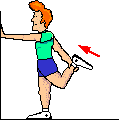
5. Wall Pushup #1: Stand about three feet from a wall, feet at shoulder width and flat on the ground. Put your hands on the wall with your arms straight for support. Lean your hips forward and bend your knees slightly to stretch your calves.
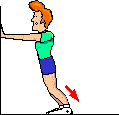
6. Wall Pushup #2: From the previous position, bend forward to lower your body to waist height. Bring one foot forward with your knee slightly bent. Lift the toes of the front foot to stretch the muscle under the calf. Stretch both legs.
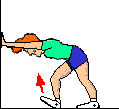
7. Wall Pushup #3: Put your feet together, rocking back on your heels with your hands on the wall and your arms straight to form a jackknife with your body. This stretches your hips, shoulders, and lower back.
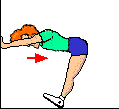
8. Hip & Lower Back Stretch: Sit on the ground with your legs crossed. Lift your right leg and cross it over the left, which should remain bent. Hug the right leg to your chest and twist the trunk of your body to look over your right shoulder. Change legs and repeat (i.e. looking over your left shoulder).

9. Iliotibial Band Stretch: Lie on your side with both legs bent in running position. Bring the bottom leg toward your chest and then bring the top one back toward your buttocks, so that the running position of your legs is exaggerated as possible. Hold for 30 seconds then flip sides and repeat.

10. Bridge: Lie on your back and, with your feet flat on the ground, lift your hips up until your body forms a flat plane. Repeat this one ten times for 30 seconds each to stretch your quads and lower back.

11. Groin Stretch: Seated, put the soles of your feet together. With your elbows on the inside of your knees, gradually lean forward and gently press your knees toward the ground.

12. Back Scratch: Grab your elbow with the opposite hand and gently push the elbow up and across your body until your hand reaches down to "scratch" your back. Gently push on your elbow to guide your hand down your back as far as it will comfortably go, stretching your triceps and shoulders. Stretch both arms.
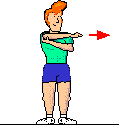
Yoga: Although yoga and running lie on opposite ends of the exercise spectrum, the two need not be mutually exclusive. Runners often experience bad backs and knees, tight hamstrings, and sore feet. It's not surprising, during the course of an average mile run, your foot will strike the ground 1,000 times. The force of impact on each foot is about three to four times your weight. All sports injuries are caused by imbalances. The pain most runners feel is not from the running in and of itself, but from imbalances that running causes and exacerbates. If you bring your body into balance through the practice of yoga, you can run long and hard for years to come. To increase range of motion, agility, flexibility, lung capacity, endurance, and strength, click here.
Injury Prevention
Cross Training | Massage | Strengthening | Stretching | Yoga
top of page
Decrease Muscle Soreness: Stretching at any time will increase blood flow to the muscles and can relieve tightness.
For Body & Mind: Increase confidence, control stress, and promote peace of mind. Yoga improves your posture and circulation and increases your flexibility, strength, and coordination.

Increase Athletic Performance: If you take time to stretch, it will increase your athletic performance. A more flexible muscle is capable of exerting a greater force and will not fatigue as easily. Improving flexibility increases your range of motion, which allows you to react to the demands of running and working out. Along with increased explosiveness and speed, more flexible muscles lead to less chance of injury.
Increase Flexibility: The main purpose of stretching is to increase flexibility. An added bonus is the ability to improve athletic performance, prevent injury, and ease some soreness. Flexibility is part of the balance of a healthy lifestyle. To really gain flexibility, stretch after your workout. You can still stretch lightly before your workout, but make sure to get a sweat going before doing so.
What to Stretch: Focus on the muscles you use the most. For runners, you should stretch hamstrings (the back of your thighs), quadriceps (the front of your thighs), calves, hips, and back.
When to Stretch: Before or after? Both - if you have the time! But, be sure to jog lightly for 5-10 minutes to warm up your muscles before you stretch. Stretching cold muscles can lead to injury, so warming up first is important. If you're pressed for time, wait and stretch after you run. Stretching after you run is more beneficial for your increased flexibility since your blood is flowing and muscles are warm. A good stretching routine will enhance your performance through increased flexibility and stride length.
Runner Girl's Recommended Stretching Routine:
1. Hamstring Stretch: Lie on your back with one leg straight up in the air, the other bent with foot flat on the ground. Loop a strap or towel over the arch of the lifted foot, and gently pull on the strap as you push against it with your foot. Push only to the point where your muscles contract. Stretch both legs.

2. Hamstring & Back Stretch: Lie on your back with your knees bent. Hug your shins to your chest to stretch your hamstrings and lower back.

3. Quadriceps Stretch #1: Kneel on your knees (without resting back on your heels). Lean back with your body erect and your arms to the side. Hold for 15 seconds.

4. Quadriceps Stretch #2: Heel To Buttock - Stand on one foot, with one hand on a wall for balance. Hold the other foot with the opposite hand and raise the heel of the lifted foot to the buttocks (or as close as comfortably possible), stretching your quadriceps. Keep your body upright throughout. Change legs and repeat.

5. Wall Pushup #1: Stand about three feet from a wall, feet at shoulder width and flat on the ground. Put your hands on the wall with your arms straight for support. Lean your hips forward and bend your knees slightly to stretch your calves.

6. Wall Pushup #2: From the previous position, bend forward to lower your body to waist height. Bring one foot forward with your knee slightly bent. Lift the toes of the front foot to stretch the muscle under the calf. Stretch both legs.

7. Wall Pushup #3: Put your feet together, rocking back on your heels with your hands on the wall and your arms straight to form a jackknife with your body. This stretches your hips, shoulders, and lower back.

8. Hip & Lower Back Stretch: Sit on the ground with your legs crossed. Lift your right leg and cross it over the left, which should remain bent. Hug the right leg to your chest and twist the trunk of your body to look over your right shoulder. Change legs and repeat (i.e. looking over your left shoulder).

9. Iliotibial Band Stretch: Lie on your side with both legs bent in running position. Bring the bottom leg toward your chest and then bring the top one back toward your buttocks, so that the running position of your legs is exaggerated as possible. Hold for 30 seconds then flip sides and repeat.

10. Bridge: Lie on your back and, with your feet flat on the ground, lift your hips up until your body forms a flat plane. Repeat this one ten times for 30 seconds each to stretch your quads and lower back.

11. Groin Stretch: Seated, put the soles of your feet together. With your elbows on the inside of your knees, gradually lean forward and gently press your knees toward the ground.

12. Back Scratch: Grab your elbow with the opposite hand and gently push the elbow up and across your body until your hand reaches down to "scratch" your back. Gently push on your elbow to guide your hand down your back as far as it will comfortably go, stretching your triceps and shoulders. Stretch both arms.

Yoga: Although yoga and running lie on opposite ends of the exercise spectrum, the two need not be mutually exclusive. Runners often experience bad backs and knees, tight hamstrings, and sore feet. It's not surprising, during the course of an average mile run, your foot will strike the ground 1,000 times. The force of impact on each foot is about three to four times your weight. All sports injuries are caused by imbalances. The pain most runners feel is not from the running in and of itself, but from imbalances that running causes and exacerbates. If you bring your body into balance through the practice of yoga, you can run long and hard for years to come. To increase range of motion, agility, flexibility, lung capacity, endurance, and strength, click here.
Injury Prevention
Cross Training | Massage | Strengthening | Stretching | Yoga
|
For Email Marketing you can trust
|

|

|
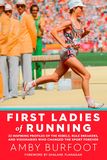
RunnerGirl Bookstore |

|
|
|

